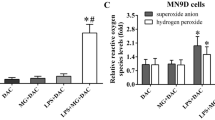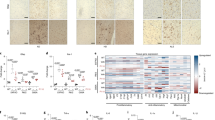Abstract
Transection of the medial forebrain bundle caused apoptosis of dopamine neurons in the rat substantia nigra. Immunohistochemical localization of activated microglia and tyrosine hydroxylase in the axotomized substantia nigra showed that activation of microglia was rapid and OX-6 (MHC-II marker)-positive and ED1 (lysosomal phagocytic marker)-positive microglia were apposed to structurally intact tyrosine hydroxylase-positive dopamine neurons, indicating microglial phagocytosis of degenerating dopamine neurons. The occurrence of microglial phagocytosis at early stages of apoptosis may indicate the evolution of apoptosis into an irreversible state. Alternatively, interventions that suppress early activation of microglia might lead to novel mechanisms for neuron protection.
Similar content being viewed by others
REFERENCES
Adayev, T., Estephan, R., Maserole, S., Mazza, B., Yurkow, E., and Benerjee, P. (1998). Externalization of phosphatidylserine may not be an early signal of apoptosis in neuronal cells, but only the phosphtidylserine-displaying apoptotic cells are phagocytosed by microglia. J. Neurochem. 71:1854–1864.
Bauer, J., Sminia, T., Wouterlood, F. G., and Dijkstra, C. D. (1994). Phagocytic activity of macrophages and microglial cells during the course of acute and chronic relapsing experimental autoimmune encephalomyelitis. J. Neurosci. Res. 38:365–375.
Blinzinger, K., and Kreutzberg, G. (1968). Displacement of synaptic terminals from regenerating motor neurons by microglial cells. Z. Zellforsch. Mikrosk. Anat. 85:145–157.
Cho, S., Park, E. M., Kim, Y., Liu, N., Gal, J., Volpe, B. T., and Joh, T. H. (2001). Early c-fos induction after cerebral ischemia: A possible neuroprotective role. J. Cereb. Blood Flow Metab. 21:550–556.
Cho, S., Volpe, B. T., Bae, Y., Hwang, O., Choi, H. J., Gal, J., Park, L. C., Chu, C. K., Du, J., and Joh, T. H. (1999). Blockade of tetrahydrobiopterin synthesis protects neurons after transient forebrain ischemia in rat: A novel role for the cofactor. J. NeuroSci. 19:10–20.
Clarke, P. G. H. (1998). Apoptosis versus necrosis: How valid a dichotomy for neurons. In Koliatos, V. E., and Rata, R. R. (eds.), Cell Death and Diseases of the Nervous System, Hamana Press, Totowa, NJ, pp. 3–28.
Fadok, V. A., Bratton, D. L., and Henson, P. M. (2001). Phagocyte receptor for apoptotic cells: Recognition, uptake, and consequences. J. Clin. Invest. 108:957–962.
Fadok, V. A., Bratton, D. L., Rose, D. M., Pearson, A., and Ezekewitz, R. A. (2000). A receptor for phosphatidylserine-specific clearance of apoptotic cells. Nature 405:85–90.
Flaris, N. A., Densmore, T. L., Molleston, M. C., and Hickey, W. F. (1993). Characterization of microglia and macrophages in the central nervous system of rats: Definition of the differential expression of molecules using standard and novel monoclonal antibodies in normal CNS and in four models of parenchymal reaction. Glia 7:34–40.
Graeber, M. B., Lez-Redondo, F., Ikoma, E., Ishikawa, M., Imai, Y., Nakajima, K., Kreuzberg, G. W., and Kohsaka, S. (1998). The microglia /macrophage response in the neonatal rat facial nucleus following axotomy. Brain Res. 813:241–253.
Graeber, M. B., Streit, W. J., Kiefer, R., Shoen, S. W., and Kreutzberg, G. W. (1990). New expression of myelomonocytic antigens by microglia and perivascular cells following lethal motor neuron injury. J. Neuroimmunol. 27:121–132.
Huynh, M. N., Fadok, V. A., and Henson, P. M. (2002). Phosphatidyloserine-dependent ingestion of apoptotic cells promotes TGF-b1secretion and the resolution of inflammation. J. Clin. Invest. 109:41–50.
Kagan, V. E., Fabisiak, J. P., Shvedova, A. A., Tyurina, Y. Y., Tyurin, V. A., Schor, N. F. and Kawai, K. (2000). Oxidative signaling pathway for externalization of plasma membrane phosphatidylserine during apoptosis. FEBS Lett. 477:1–7.
Koliatsos, V. E., and Mocchetti, I. (1998). Trophic factors as therapeutic agents for diseases characterized by neuronal death. In Koliatsos, V. E., and Rata, R. R., (eds.), Cell Death and Diseases of the Nervous System, Humana Press, Totowa, NJ, pp. 545–591.
Kreutzberg, G. W. (1996). Microglia: A sensor for pathological events in the CNS. Trends Neurosci. 19:312–318.
Kreutzberg, G. W., and Barron, K. D. (1978). 5'-Nucleotidase of microglial cells in the facial nucleus during axonal reaction. J. Neurocytol. 7:601–610.
Lassmann, H., Schmied, M., Vass, K., and Hickey, W. F. (1993). Bone marrow derived elements and resident microglia in brain inflammation. Glia:19–24.
McGeer, P., Itagaki, S., Boyes, B. E., and McGeer, E. G. (1988). Reactive microglia are positive for HLA-DR in the substantia nigra of Parkinson's and Alzheimer's disease brains. Neurology 38:1285–1291.
Pittman, R. N., Messam, C. A., and Mills, J. C. (1998). Asynchronous death as a characteristics feature of apoptosis. In Koliatos, V. E., and Rata, R. R. (eds.), Cell Death and Diseases of the Nervous System, Hamana Press, Totowa, NJ, pp. 29–44.
Platt, N., da Silva, R. P., and Gordon, S. (1998). Recognizing death: The phagocytosis of apoptotic cells. Trends Cell Biol. 8:365–372.
Raivich, G., Bohatschek, M., Kloss, C. U. A., Werner, A., Jones, L. L., and Kreutzberg, G. W. (1999). Neuroglial activation repertoire in the injured brain: Graded response, molecular mechanisms and cues to physiological function. Brain. Res. Rev. 30:77–105.
Reis, O. J., and Ross, R. A. (1973). Dynamic changes in brain dopamine β-hydroxylase activity during anterograde and retrograde reactions to injury of cerebral horadrenergic neurons. Brain Res. 57:307–326.
Ross, R. A., and Reis, O. J. (1975). Reversible changes in the accumulation and activities of tyrosine hydroxylase and dopamine in neurons of nucleus locas cerulens during the retrograde reactrons. Brain Res. 92:57–72.
Roy, M., and Sapolsky, R. (2000). Neuronal apoptosis in acute necrotic insults: Why is this subject such a mess? Trends NeuroSci. 22:419–422.
Savill, J. (1998). Apoptosis. Phagocytic docking without shocking. Nature 392:442–443.
Savill, J., and Fadok, V. A. (2000). Corpse clearance defines the meaning of cell death. Nature 407:784–788.
Streit, W. J., Graeber, M. B., and Kreutzberg, G. W. (1988). Functional plasticity of microglia. Glia 1:301–307.
Streit, W. J., Graeber, M. B., and Kreutzberg, G. W. (1989). Expression of Ia antigen on perivascular and microglial cells after sublethal and lethal motor neuron injury. Exp. Neurol. 105:115–126.
Streit, W. J., and Kreutzberg, G. W. (1988). Response of endogenous glial cells to motor neuron degeneration induced by toxin ricin. J. Comp. Neurol. 268:248–263.
Sugama, S., Cho, B. P., DeGiorgio, L. A., Shimizu, Y., Kim, S. S., Kim, Y. S., Shin, D. H., Volpe, B. T., Reis, D. J., Cho, S., and Joh, T. H. (2003). Temporal and sequential analysis of microglia in the substantia nigra following medial forebrain bundle axotomy in rat. Neuroscience 16:925–933.
Tatton, N. A., and Kish, S. J. (1997). In situ detection of apoptotic nuclei in the substantia nigra compacta of 1-methyl-4-phenyl-1,2,3,6-tetrahydropyridine-treated mice using terminal deoxynucleotidyl transferase labelling and acridine orange staining. Neuroscience 77:1037–1048.
Weiser, M., Baker, H., Wessel, T., and Joh, T. H. (1993). Axetomy-induced differential gene induction in neurons of the locus ceroleus and substantia nigra. Mol. Brain Res. 17:319–327.
Witting, A. P., Muller, A., Herrmann, H., Kettenmann, and C. Nolte (2000). Phagocytic clearance of apoptotic neurons by microglia/brain macrophages in vitro: Involvement of lectin-, integrin-, and phosphatidylserine-mediated recognition. J. Neurochem. 75:1060–1070.
Author information
Authors and Affiliations
Corresponding author
Rights and permissions
About this article
Cite this article
Cho, B.P., Sugama, S., Shin, D.H. et al. Microglial Phagocytosis of Dopamine Neurons at Early Phases of Apoptosis. Cell Mol Neurobiol 23, 551–560 (2003). https://doi.org/10.1023/A:1025024129946
Issue Date:
DOI: https://doi.org/10.1023/A:1025024129946




